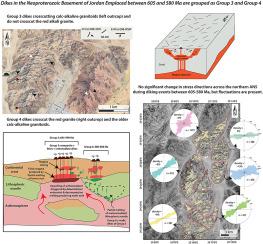阿拉伯-努比亚地盾西北端新元古代岩脉群的地球化学和空间分布:地壳伸展的意义
IF 2.2
4区 地球科学
Q2 GEOSCIENCES, MULTIDISCIPLINARY
引用次数: 0
摘要
阿拉伯-努比亚地盾(ANS)中的埃迪卡拉岩脉群为研究碰撞后的构造和岩浆活动提供了关键的见解。本研究提供了约旦西南部最北端ANS暴露的堤群的新化学数据、两个40Ar/39Ar年龄和空间分布分析。侵入Saramuj砾岩的煌斑岩基台的角闪石测定的高原年龄为~ 592±3 Ma,可解释为基台的结晶年龄。侵入~ 586 Ma碱花岗岩的斑岩脉蚀变斜长石斑晶中富绢云母域的微核产生的年龄为~ 580 ~ 570 Ma,被解释为热液蚀变年龄,限制了脉位在586 ~ 580 Ma。所调查岩浆岩的地球化学特征表现为碱性-亚碱性和钙碱性岩浆岩的交叉剖面。这一转变反映了从挤压到伸展(~ 610-590 Ma)的转变、岩石圈变薄和地幔源的变化。590 Ma以后,岩浆作用转为纯碱性,形成a型花岗类和白云岩,标志着向伸展岩浆作用的转变。岩脉主要沿NE-SW和E-W走向,少见N-S、NW-SE和WNW-ESE走向,显示主要水平延伸方向为NW-SE至N-S。岩脉密度范围为5% ~ 13%,平均为~ 9%,地壳伸展估计为9 ~ 23%,平均为16%。岩脉组成、取向和侵位顺序之间没有相关性,表明在岩脉演化的最后阶段(605-580 Ma),岩脉的应力取向是一致的。本文章由计算机程序翻译,如有差异,请以英文原文为准。

Geochemistry and spatial distribution of Neoproterozoic dike swarms from the northwestern tip of the Arabian-Nubian Shield: Implications for crustal extension
Ediacaran dike swarms in the Arabian-Nubian Shield (ANS) provide key insights into post-collisional tectonics and magmatism. This study presents new chemical data, two 40Ar/39Ar ages, and spatial distribution analysis for dike swarms in the northernmost ANS exposures in SW Jordan. Hornblende from a lamprophyre sill intruding the Saramuj Conglomerate yielded a plateau age of ∼592 ± 3 Ma, interpreted as the crystallization age of the sill. Micro-cores of sericite-rich domains in altered plagioclase phenocrysts from a dolerite dike intruding ∼586 Ma alkali granite produced ages of ∼580–570 Ma, interpreted as hydrothermal alteration ages, constraining dike emplacement to 586–580 Ma. The geochemistry of investigated dikes varies from alkaline to subalkaline and crosscuts calc-alkaline magmatic rocks. This transition reflects a shift from compression to extension (∼610-590 Ma), lithospheric thinning, and changes in mantle sources. After 590 Ma, magmatism became exclusively alkaline, forming A-type granitoids and dolerites, marking a shift to extensional magmatism. Dikes predominantly follow NE-SW and E-W orientations, with rare N-S, NW-SE, and WNW-ESE trends, suggesting a major horizontal extension direction from NW-SE to N-S. Dike density ranges from 5 to 13 %, averaging ∼9 %, with crustal extension estimates of 9–23 %, averaging 16 %. No correlation was found between dike composition, orientation, or order of emplacement, indicating consistent stress orientation during the final stage (605-580 Ma) of ANS evolution.
求助全文
通过发布文献求助,成功后即可免费获取论文全文。
去求助
来源期刊

Journal of African Earth Sciences
地学-地球科学综合
CiteScore
4.70
自引率
4.30%
发文量
240
审稿时长
12 months
期刊介绍:
The Journal of African Earth Sciences sees itself as the prime geological journal for all aspects of the Earth Sciences about the African plate. Papers dealing with peripheral areas are welcome if they demonstrate a tight link with Africa.
The Journal publishes high quality, peer-reviewed scientific papers. It is devoted primarily to research papers but short communications relating to new developments of broad interest, reviews and book reviews will also be considered. Papers must have international appeal and should present work of more regional than local significance and dealing with well identified and justified scientific questions. Specialised technical papers, analytical or exploration reports must be avoided. Papers on applied geology should preferably be linked to such core disciplines and must be addressed to a more general geoscientific audience.
 求助内容:
求助内容: 应助结果提醒方式:
应助结果提醒方式:


